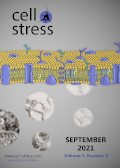Table of contents
Volume 5, Issue 9, pp. 128 - 145, September 2021
Cover: This month in
Cell Stress: Autophagy regulators in membrane stress. Image Credit: OpenStax via Wikimedia Commons. The cover is published under the
CC BY 4.0 license.
Enlarge issue cover
Atg8ylation as a general membrane stress and remodeling response
Suresh Kumar, Jingyue Jia and Vojo Deretic
Reviews |
page 128-142 | 10.15698/cst2021.09.255 | Full text | PDF |
Abstract
The yeast Atg8 protein and its paralogs in mammals, mammalian Atg8s (mAtg8s), have been primarily appreciated for their participation in autophagy. However, lipidated mAtg8s, including the most frequently used autophagosomal membrane marker LC3B, are found on cellular membranes other than autophagosomes. Here we put forward a hypothesis that the lipidation of mAtg8s, termed ‘Atg8ylation’, is a general membrane stress and remodeling response analogous to the role that ubiquitylation plays in tagging proteins. Ubiquitin and mAtg8s are related in sequence and structure, and the lipidation of mAtg8s occurs on its C-terminal glycine, akin to the C-terminal glycine of ubiquitin. Conceptually, we propose that mAtg8s and Atg8ylation are to membranes what ubiquitin and ubiquitylation are to proteins, and that, like ubiquitylation, Atg8ylation has a multitude of downstream effector outputs, one of which is autophagy.
Host upregulation of lipid droplets drives antiviral responses
Ebony A. Monson and Karla J. Helbig
Microreviews |
page 143-145 | 10.15698/cst2021.09.256 | Full text | PDF |
Abstract
When a host cell is infected by a virus, it activates the innate immune response, setting off a cascade of signalling events leading to the production of an antiviral response. This immune response is typically robust and in general works well to clear viral infections, however, viruses have evolved evasion strategies to combat this, and therefore, a better understanding of how this response works in more detail is needed for the development of novel and effective therapeutics. Lipid droplets (LDs) are intracellular organelles and have historically been thought of simply as cellular energy sources, however, have more recently been recognised as critical organelles in signalling events. Importantly, many viruses are known to take over host cellular production of LDs, and it has traditionally been assumed the sole purpose of this is to supply energy for viral life cycle events. However, our recent work positions LDs as important organelles during the first few hours of an antiviral response, showing that they underpin the production of important antiviral cytokines following viral infection. Following infection of cells with either RNA viruses (Zika, Dengue, Influenza A) or a DNA (Herpes Simplex Virus-1) virus, LDs were rapidly upregulated, and this response was also replicated following stimulation with viral mimic agonists. This upregulation of LDs following infection was transient, and interestingly, did not follow the well described homeostatic mechanism of LD upregulation, instead being controlled by EGFR. The cell’s ability to mount an effective immune response was greatly diminished when inhibiting EGFR, thus inhibiting LD upregulation during infection, also leading to an increase in viral replication. In this microreview, we extrapolate our recent findings and discuss LDs as an important organelle in the innate immune response.



